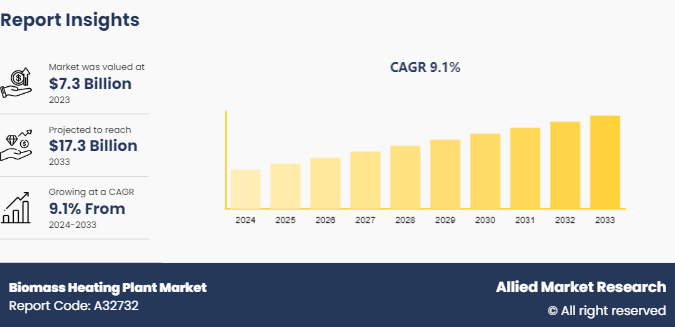
Biomass Heating Plant Market to Reach $17.3 Billion, Globally, by 2033 at 9.1% CAGR: Allied Market Research

The global market is growing as demand rises for biomass, a renewable energy source derived from organic materials, offering a sustainable heating solution.
WILMINGTON, DE, UNITED STATES, December 3, 2024 /EINPresswire.com/ -- Allied Market Research published a report, titled, "Biomass Heating Plant Market by Fuel Type (Solid Biomass, Liquid Biomass and Gaseous Biomass), End-Use (Residential, Commercial and Industrial), Technology (Direct Combustion, Gasification, Anaerobic Digestion and Others): Global Opportunity Analysis and Industry Forecast, 2024-2033". According to the report, the biomass heating plant market was valued at $7.3 billion in 2023, and is estimated to reach $17.3 billion by 2033, growing at a CAGR of 9.1% from 2024 to 2033.
Download Sample PDF: https://www.alliedmarketresearch.com/request-sample/A32732
Prime determinants of growth
The global biomass heating plant market is experiencing growth due to Increase in demand for renewable energy sources. However, the high initial investment cost for biomass heating plants is expected to hinder the growth of biomass heating plant market. Moreover, increase in use of biomass plants convert waste materials offers remunerative opportunities for the expansion of the global biomass briquette market.
The solid biomass segment is expected to remain the largest type throughout the forecast period
By fuel type, solid biomass usage in biomass-fired heating plants involves the combustion of organic materials to produce heat energy. These materials, which are often sourced from agricultural residues, forestry waste, wood pellets, and dedicated energy crops, serve as a renewable energy source that helps reduce dependency on fossil fuels and lowers greenhouse gas emissions. The process begins with the collection and preparation of biomass feedstock. This biomass is typically dried and processed to ensure it has a consistent moisture content and particle size, which is crucial for efficient combustion.
The industrial segment is expected to lead throughout the forecast period
In industrial applications, biomass-fired heating plants are often used for process heating, which is essential for various manufacturing processes. Industries such as paper and pulp, food and beverage, and chemical manufacturing require substantial amounts of heat for processes like drying, steaming, and cooking. Biomass-fired heating plants provide a reliable and cost-effective solution for these thermal energy needs. By using locally sourced biomass, industries can reduce energy costs and improve energy security, as biomass resources are often more stable in price compared to fossil fuels.
Enquiry Before Buying: https://www.alliedmarketresearch.com/purchase-enquiry/A32732
The direct combustion segment is expected to remain the largest type throughout the forecast period
By technology, direct combustion is the most common and straightforward method of biomass energy conversion used in biomass-fired heating plants. In this process, biomass materials such as wood chips, agricultural residues, and other organic waste are burned in a furnace or boiler to generate heat. This heat can then be used directly for heating purposes or to produce steam, which drives a turbine connected to an electricity generator. The biomass materials are collected, dried, and sometimes processed into uniform sizes to ensure efficient combustion. The prepared biomass is then fed into a combustion chamber, where it is ignited and burned at high temperatures. The combustion process converts the chemical energy stored in the biomass into thermal energy. This thermal energy is transferred to water or another working fluid in the boiler, generating steam.
Asia-Pacific to maintain its dominance by 2033
Region wise, biomass-fired heating plants have become increasingly significant in Asia-Pacific countries, driven by the region's need to diversify energy sources, enhance energy security, and reduce greenhouse gas emissions. Biomass, derived from organic materials such as agricultural residues, wood pellets, and waste, provides a renewable and sustainable source of energy.
China is a leader in biomass energy utilization within the Asia-Pacific region. The country has implemented numerous biomass-fired heating projects, particularly in rural areas where agricultural residues are readily available. Japan has also made significant strides in biomass energy, with a focus on both heating and power generation. In the aftermath of the Fukushima disaster, Japan has sought to diversify its energy portfolio, and biomass offers a viable alternative. The country's biomass-fired heating plants primarily use wood pellets and agricultural waste. India is another key player in the Asia-Pacific biomass energy market. The country's vast agricultural sector produces substantial amounts of residues, which are utilized in biomass-fired heating plants.
Connect To Analyst: https://www.alliedmarketresearch.com/connect-to-analyst/A32732
Players: -
• Babcock & Wilcox Enterprises, Inc
• Siemens AG
• Valmet
• Doosan Enerbility
• Thermax Limited
• HoSt Energy Systems
• Hurst Boiler & Welding Co, Inc
• Energy Saving Trust
• Treco Ltd
• Aalborg Energie Technik a/s
The report provides a detailed analysis of these key players in the global biomass briquettes market. These players have adopted different strategies such as new product launches, collaborations, expansion, joint ventures, agreements, and others to increase their market share and maintain dominant shares in different regions. The report is valuable in highlighting business performance, operating segments, product portfolio, and strategic moves of market players to showcase the competitive scenario.
David Correa
Allied Market Research
+15038946022 ext.
email us here
Visit us on social media:
Facebook
X
Distribution channels: Energy Industry, Environment
Legal Disclaimer:
EIN Presswire provides this news content "as is" without warranty of any kind. We do not accept any responsibility or liability for the accuracy, content, images, videos, licenses, completeness, legality, or reliability of the information contained in this article. If you have any complaints or copyright issues related to this article, kindly contact the author above.
Submit your press release